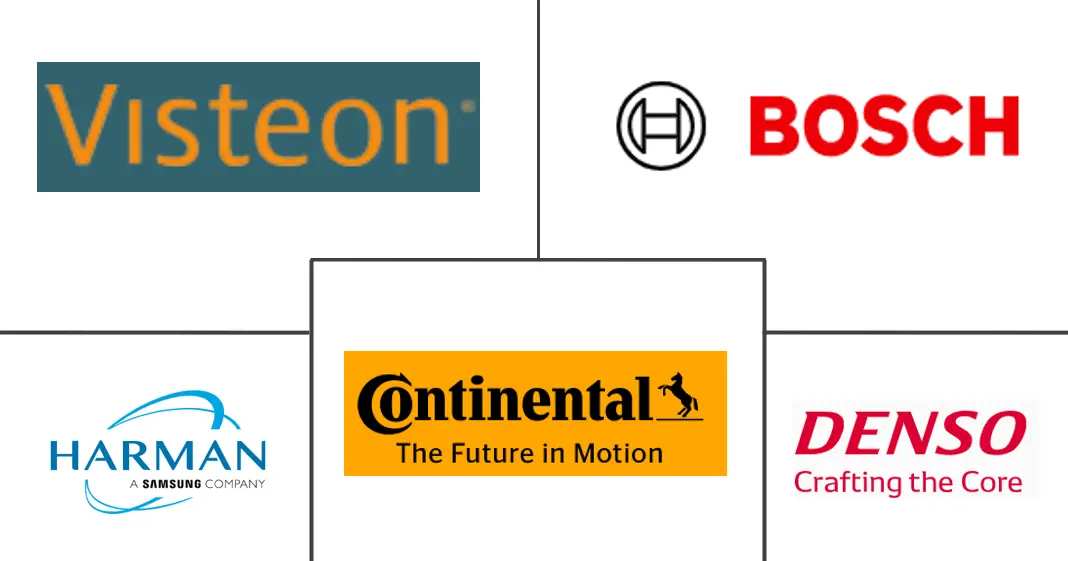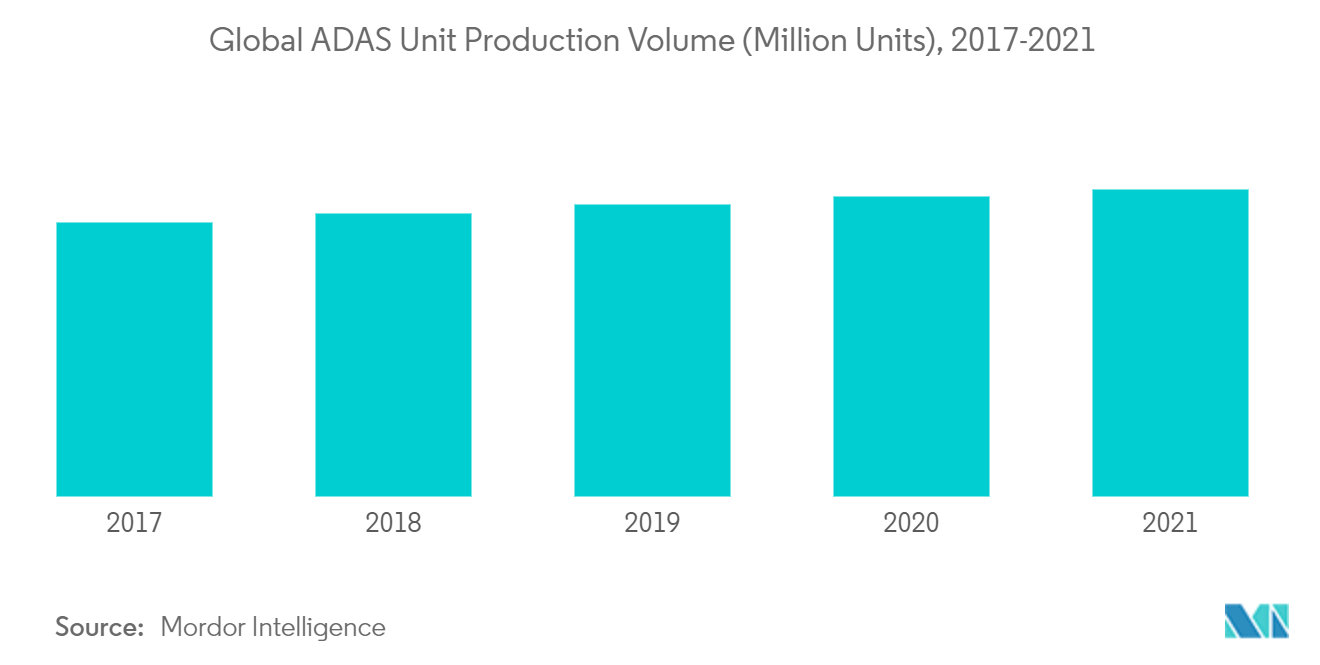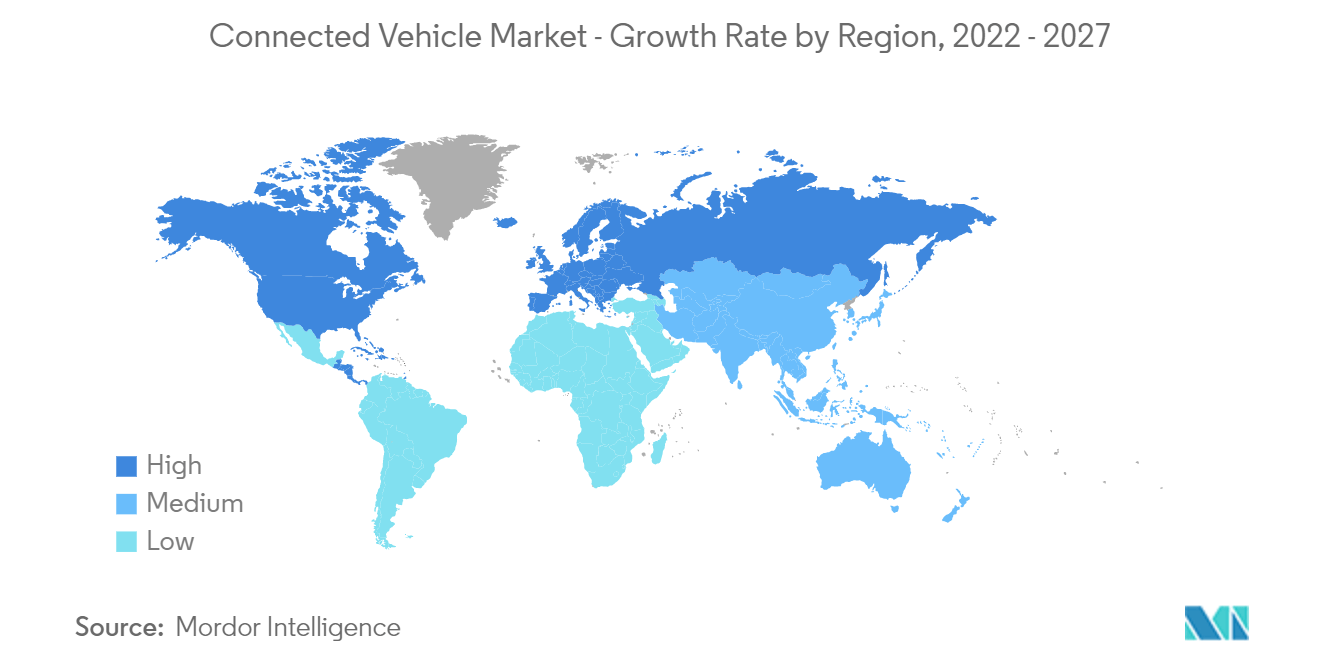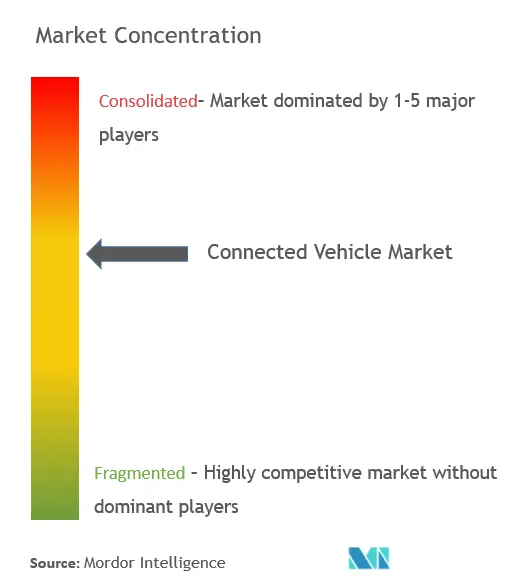Connected Vehicle Market Size

| Study Period | 2019 - 2029 |
| Market Size (2024) | USD 74.39 Billion |
| Market Size (2029) | USD 165.53 Billion |
| CAGR (2024 - 2029) | 17.35 % |
| Fastest Growing Market | Asia Pacific |
| Largest Market | Asia-Pacific |
Major Players
*Disclaimer: Major Players sorted in no particular order |
Connected Vehicle Market Analysis
The Connected Vehicle Market size is estimated at USD 74.39 billion in 2024, and is expected to reach USD 165.53 billion by 2029, growing at a CAGR of 17.35% during the forecast period (2024-2029).
The COVID-19 pandemic had a massive impact on the market studied as lockdowns and trade restrictions have led to supply chain disruptions and a halt of vehicle production across the globe. However, as restrictions eased, players started focusing on mitigating such risks and developments to create momentum in the market during the forecast period.
The rising integration of advanced safety and comfort features in the vehicle, such as advanced driver assistance systems, vehicle infotainment, and many others witnessing major growth in the market. Growing production of vehicles with integrated ADAS features in the wake of rising awareness toward comfort and safety of passengers and government regulations mandating safety features are expected to drive demand in the market. Moreover, the rising acceptance of self-driving or automated vehicles further contributes to the enhanced growth of the market.
Governments across the globe are focusing on designing several legislative policies and regulations to monitor the users and are proposing policies mandating and encouraging consumers to install ADAS components in vehicles to mitigate rising road accidents across several countries. For instance, the Indian government has already mandated a requirement for ABS on motorcycles with a focus on improving vehicle safety. Currently, India is working to make Electronic Stability Control (ESC) and Autonomous Emergency Braking (AEB) mandatory in cars by 2022-2023.
Connected Vehicle Market Trends
This section covers the major market trends shaping the Connected Vehicle Market according to our research experts:
Growing demand for ADAS features in vehicle
Autonomous cars and connected vehicles are gaining consumers' interest and are anticipated to gain wider acceptance over the forecast period. The advanced driver assistance systems (ADAS) featured are expected to diminish the penetration gap between traditional cars and tomorrow's cars. Moreover, With the rising technological advancements in the automotive industry, end users are ready to spend more on the latest technologies, which enhance the driving experience and increase the safety of drivers and riders. ADAS features, such as collision warning, lane assistance, blind spot detection, etc., have a significant impact on consumer behavior and are expected to enhance vehicles' performance by reducing vehicle downtime by alerting the owner of any faults in the vehicle.
ADAS has advanced considerably, but there is still a long way to go with connected vehicle technology. V2V communication has the potential to upgrade it further, as vehicles may communicate with each other directly and share information on relative speeds, positions, directions of travel, and even control inputs, such as sudden braking, accelerations, or changes in direction. By using this data with the vehicle's sensor inputs, it is possible to create a more detailed picture of the surrounding area and provide more accurate warnings or even corrective actions to avoid collisions.
However, the number of ADAS components may keep growing, as these previously available systems in high-end models are now being used in entry-level vehicles. These systems bring added safety and security to daily driving. Many of these systems allow the vehicle to make driving adjustments according to the condition. Functions, such as steering, braking, and accelerating, can be performed by the vehicle in certain situations. For instance,
Research conducted by Canalys shows that the lane-keep assist feature, which when activated provides steering assistance to keep a vehicle in its lane, was installed in 56% of new cars sold in Europe in the first half of 2021, 52% in Japan, 30% in Mainland China, and 63% in the United States.
Many technology companies in the market are teaming up to solve the complexities of developing advanced driver-assistance systems (ADAS). For instance,
- In June 2022, PATEO Corporation and Qualcomm Technologies, Inc. (Qualcomm) expanded their relationship to develop solutions to support vehicle intelligence, smart car connectivity, Service-Oriented Architecture (SOA), and intelligent cockpits and multi-domain fusion based on central controllers.
- In July 2021, Magna International Inc. announced its plans to acquire safety tech major Veoneer Inc. Magna International Inc. entered a definitive merger agreement with Veoneer Inc., under which the company plans to acquire Veoneer Inc., a leading player in automotive safety technology. With this acquisition, Magna's aimed to strengthen and broaden its ADAS portfolio and industry position.

Asia-Pacific is Likely to Lead the Connected Vehicle Market
Asia-Pacific is likely to lead the connected vehicle market over the forecast owing to the increase in the connectivity features in the latest car models. The rise in demand for digital features in vehicles, especially in developing countries like China and India, is anticipated to drive the connected vehicle market in the region.
China is one of the largest automotive markets in the world, and more than 21.48 million passenger cars were sold in the country in 2021 and recorded a 6% surge in sales compared to 2020. Despite the pandemic, China is still one of the largest sellers of automobiles, which is a great opportunity for predictive technology to make its place in the Chinese automobile market.
The Chinese government is focusing on several advanced vehicles technology, like ADAS features, along with electric mobility. With that, major automakers in the country are updating their portfolio with the introduction of the new level 2 and level 3 ADAS features. For instance,
- In May 2021, the HAVAL brand of Great Wall Motor Co. Ltd launched the new Chitu compact SUV, and it is equipped with a 1.5L turbocharged engine (maximum power output of 135kW, peak torque of 275Nm) in combination with a 7-speed wet dual-clutch transmission. In addition, the vehicle includes a Level 2 ADAS system, with varying functions depending on the version.
India has a potential and opportunity for a connected vehicle market as India is stepping gradually into the autonomous and artificial intelligence-oriented automotive industry along with many new product launches. For instance,
- In 2021, Morris Garage launched its new SUV Gloster, which is equipped with the latest ADAS features based on predictive technology such as automatic emergency brake, automatic parking assist, blind spot detection, forward collision warning, and lane departure warning. MG, in 2021, has launched another SUV, the Astor, an affordable compact SUV with level-2 ADAS features such as Adaptive Cruise Control, Automatic Emergency Braking, Blind Spot Detection, Lane-keeping Assist, and Lane Departure Warning.
Followed by Asia-Pacific, North America, and Europe, also witnessing significant market share in terms of revenue and are projected to grow during the forecast period. Initiatives toward the predictive technology sector, such as implementing ADAS features in cars, are going to boost the market.

Connected Vehicle Industry Overview
The connected vehicle market is dominated by Continental AG, Robert Bosch GmbH, Harman International Industries, Inc., DENSO Corporation, Airbiquity Inc, and Visteon Corporation. Connected vehicles' features are poised to become a common phenomenon in developing nations such as China, India, etc., market over the forecast period, as OEMs have started offering connected car features in their new respective models. For instance,
- In May 2022, LEVC (London Electric Vehicle Company) announced a new partnership with the global leader in IoT and connected transportation, Geotab, providing state-of-the-art fleet management systems on its class-leading electric TX taxi and VN5 van.
- In August 2021, Robert Bosch GmbH joined with Mahindra & Mahindra for the development of a connected vehicle platform. This partnership helps to grow and boost the connected platform in vehicles.
- In February 2021, Ford Motors and Google signed a strategic partnership for the development of connected car service applications. This partnership helps to enhance the ford motors connected vehicle business.
Connected Vehicle Market Leaders
-
Continental AG
-
Robert Bosch GmbH
-
Visteon Corporation
-
Harman International
-
Denso Corporation
*Disclaimer: Major Players sorted in no particular order

Connected Vehicle Market News
- In May 2022, Toyota Connected North America introduced cabin awareness concept technology that uses millimeter-wave, high-resolution 4D imaging radar to help detect occupants (including certain pets) in cars.
- In April 2022, Obigo Inc. (Obigo) and Korea Electric Technology Institute (KETI) jointly developed 5G-NR-V2X technologies for connected and autonomous driving vehicles.
- In January 2022, Aptiv PLC introduced a next-generation advanced driver-assistance system (ADAS) for autonomous and electric vehicles. This will aid in reducing the cost of software-driven vehicles due to Aptiv's scalable architecture.
- In November 2021, Continental introduced a technology solution for highly automated driving consisting of intelligent software that enables complex autonomous driving. The Next Generation Driving Planner is an innovative software solution that enables highly automated driving from Level 3.
Connected Vehicle Market Report - Table of Contents
1. INTRODUCTION
- 1.1 Study Assumptions
- 1.2 Scope of the Study
2. RESEARCH METHODOLOGY
3. EXECUTIVE SUMMARY
4. MARKET DYNAMICS
- 4.1 Market Drivers
- 4.2 Market Restraints
-
4.3 Porter's Five Forces Analysis
- 4.3.1 Threat of New Entrants
- 4.3.2 Bargaining Power of Buyers/Consumers
- 4.3.3 Bargaining Power of Suppliers
- 4.3.4 Threat of Substitute Products
- 4.3.5 Intensity of Competitive Rivalry
5. MARKET SEGMENTATION
-
5.1 By Technology Type
- 5.1.1 4G/LTE
- 5.1.2 3G
- 5.1.3 2G
-
5.2 By Application
- 5.2.1 Driver Assistance
- 5.2.2 Telematics
- 5.2.3 Infotainment
- 5.2.4 Others
-
5.3 By Connectivity
- 5.3.1 Integrated
- 5.3.2 Embedded
- 5.3.3 Tethered
-
5.4 By Vehicle Connectivity
- 5.4.1 Vehicle to Vehicle (V2V)
- 5.4.2 Vehicle to Infrastructure (V2I)
- 5.4.3 Vehicle to Pedestrian (V2P)
-
5.5 By Vehicle
- 5.5.1 Passenger cars
- 5.5.2 Commercial Vehicle
-
5.6 Geography
- 5.6.1 North America
- 5.6.1.1 United States
- 5.6.1.2 Canada
- 5.6.1.3 Rest of North America
- 5.6.2 Europe
- 5.6.2.1 Germany
- 5.6.2.2 United Kingdom
- 5.6.2.3 France
- 5.6.2.4 Rest of Europe
- 5.6.3 Asia-Pacific
- 5.6.3.1 India
- 5.6.3.2 China
- 5.6.3.3 Japan
- 5.6.3.4 South Korea
- 5.6.3.5 Rest of Asia-Pacific
- 5.6.4 Rest of the World
- 5.6.4.1 South America
- 5.6.4.2 Middle-East and Africa
6. COMPETITIVE LANDSCAPE
- 6.1 Vendor Market Share
-
6.2 Company Profiles*
- 6.2.1 Robert Bosch GmbH
- 6.2.2 Continental AG
- 6.2.3 Denso Corporation
- 6.2.4 Visteon Corporation
- 6.2.5 Harman International
- 6.2.6 AT&T Inc.
- 6.2.7 TomTom N.V.
- 6.2.8 Airbiquity Inc.
- 6.2.9 Qualcomm Technologies Inc.
- 6.2.10 Sierra Wireless
- 6.2.11 Infineon Technologies
- 6.2.12 Magna International
- 6.2.13 ZF Friedrichshafen AG
7. MARKET OPPORTUNITIES AND FUTURE TRENDS
** Subject To AvailablityConnected Vehicle Industry Segmentation
A connected vehicle is any type of vehicle which connect to the internet. Usually, such vehicles connect to the internet through WLAN (Wireless Local Area Network). A connected vehicle can also share the internet with devices inside and outside the car and, at the same time, can also share data with any external device/services.
The connected Vehicle market covers the latest technology trends, government policies to promote connected features in vehicles, and the market share of major connected car manufacturers across the globe. The Global connected vehicle market is segmented by technology type, application, connectivity, vehicle connectivity, vehicle type, and geography.
Based on the technology, the market is segmented into 4G, 3G, and 2G. Based on the application, the market is segmented into driver assistance, telematics and infotainment, and others. Based on the connectivity, the market is segmented into Integrated, Embedded, and Tethered. Based on the vehicle connectivity, the market is segmented into Vehicle to Vehicle (V2V), Vehicle to Infrastructure (V2I), and Vehicle to Pedestrian (V2P). Based on the vehicle, the market is segmented into passenger cars and commercial vehicles. Based on geography, the market is segmented into North America, Europe, Asia-Pacific, and the Rest of the World. The report covers the market size in value (USD Billion) for all the above segments.
| By Technology Type | 4G/LTE | |
| 3G | ||
| 2G | ||
| By Application | Driver Assistance | |
| Telematics | ||
| Infotainment | ||
| Others | ||
| By Connectivity | Integrated | |
| Embedded | ||
| Tethered | ||
| By Vehicle Connectivity | Vehicle to Vehicle (V2V) | |
| Vehicle to Infrastructure (V2I) | ||
| Vehicle to Pedestrian (V2P) | ||
| By Vehicle | Passenger cars | |
| Commercial Vehicle | ||
| Geography | North America | United States |
| Canada | ||
| Rest of North America | ||
| Geography | Europe | Germany |
| United Kingdom | ||
| France | ||
| Rest of Europe | ||
| Geography | Asia-Pacific | India |
| China | ||
| Japan | ||
| South Korea | ||
| Rest of Asia-Pacific | ||
| Geography | Rest of the World | South America |
| Middle-East and Africa |
Connected Vehicle Market Research FAQs
How big is the Connected Vehicle Market?
The Connected Vehicle Market size is expected to reach USD 74.39 billion in 2024 and grow at a CAGR of 17.35% to reach USD 165.53 billion by 2029.
What is the current Connected Vehicle Market size?
In 2024, the Connected Vehicle Market size is expected to reach USD 74.39 billion.
Who are the key players in Connected Vehicle Market?
Continental AG, Robert Bosch GmbH, Visteon Corporation, Harman International and Denso Corporation are the major companies operating in the Connected Vehicle Market.
Which is the fastest growing region in Connected Vehicle Market?
Asia Pacific is estimated to grow at the highest CAGR over the forecast period (2024-2029).
Which region has the biggest share in Connected Vehicle Market?
In 2024, the Asia-Pacific accounts for the largest market share in Connected Vehicle Market.
What years does this Connected Vehicle Market cover, and what was the market size in 2023?
In 2023, the Connected Vehicle Market size was estimated at USD 63.39 billion. The report covers the Connected Vehicle Market historical market size for years: 2019, 2020, 2021, 2022 and 2023. The report also forecasts the Connected Vehicle Market size for years: 2024, 2025, 2026, 2027, 2028 and 2029.
What drives the growth of the Connected Vehicle Market?
The Connected Vehicle Market growth is driven by a) Advancements in vehicle technology b) Increasing consumer demand for safer and more efficient driving experiences c) Government regulations for vehicle safety d) Growing integration of smartphones with vehicles
What are the key technologies in the Connected Vehicles Industry?
Key technologies in the Connected Vehicles Industry are a) Vehicle-to-Vehicle (V2V) b) Vehicle-to-Infrastructure (V2I) c) Vehicle-to-Pedestrian (V2P) communication systems d) In-vehicle infotainment systems e) Telematics f) Autonomous driving technologies
Connected Car Industry Report
The global connected car market is witnessing remarkable growth, driven by the increasing demand for advanced safety, comfort, and convenience features. This surge is attributed to the integration of connectivity solutions, which enable seamless communication with smartphones, tablets, other vehicles, and infrastructure. The market's expansion is fueled by consumer interest in anti-theft systems, advanced driver assistance systems (ADAS), and autonomous vehicle technology, enhancing driving experiences and vehicle management.
With a strong focus on intelligent transportation and the integration of 5G, AI, and V2X communications, the connected vehicles market is overcoming challenges like cybersecurity and connectivity infrastructure. The Asia-Pacific region is leading this growth, supported by digital adoption and government policies on vehicle safety and connectivity. The connected car market size is set to increase significantly, indicating a shift towards more intelligent, autonomous vehicles, promising improved safety, efficiency, and user experience.
In terms of market segmentation, the report covers various technology types such as 4G/LTE, 3G, and 2G, as well as applications including driver assistance, telematics, infotainment, and others. Connectivity options like integrated, embedded, and tethered systems are also analyzed. Additionally, the report delves into vehicle connectivity types, such as vehicle to vehicle (V2V), vehicle to infrastructure (V2I), and vehicle to pedestrian (V2P), along with vehicle categories like passenger cars and commercial vehicles.
The market analysis highlights the growth rate and industry trends, offering insights into market data, market forecast, market growth, and market outlook. The industry analysis provides an overview of the industry size, industry statistics, and industry sales, while the market review and market predictions shed light on future opportunities. The report example and report PDF offer a comprehensive understanding of the market value and market segmentation.
For those seeking detailed industry information, industry reports, and industry research, the report serves as a valuable resource. It also identifies market leaders and research companies that play a pivotal role in shaping the market landscape. The industry outlook and market overview provide a holistic view of the market dynamics, ensuring that stakeholders are well-informed about the evolving needs and opportunities within the connected car market.



